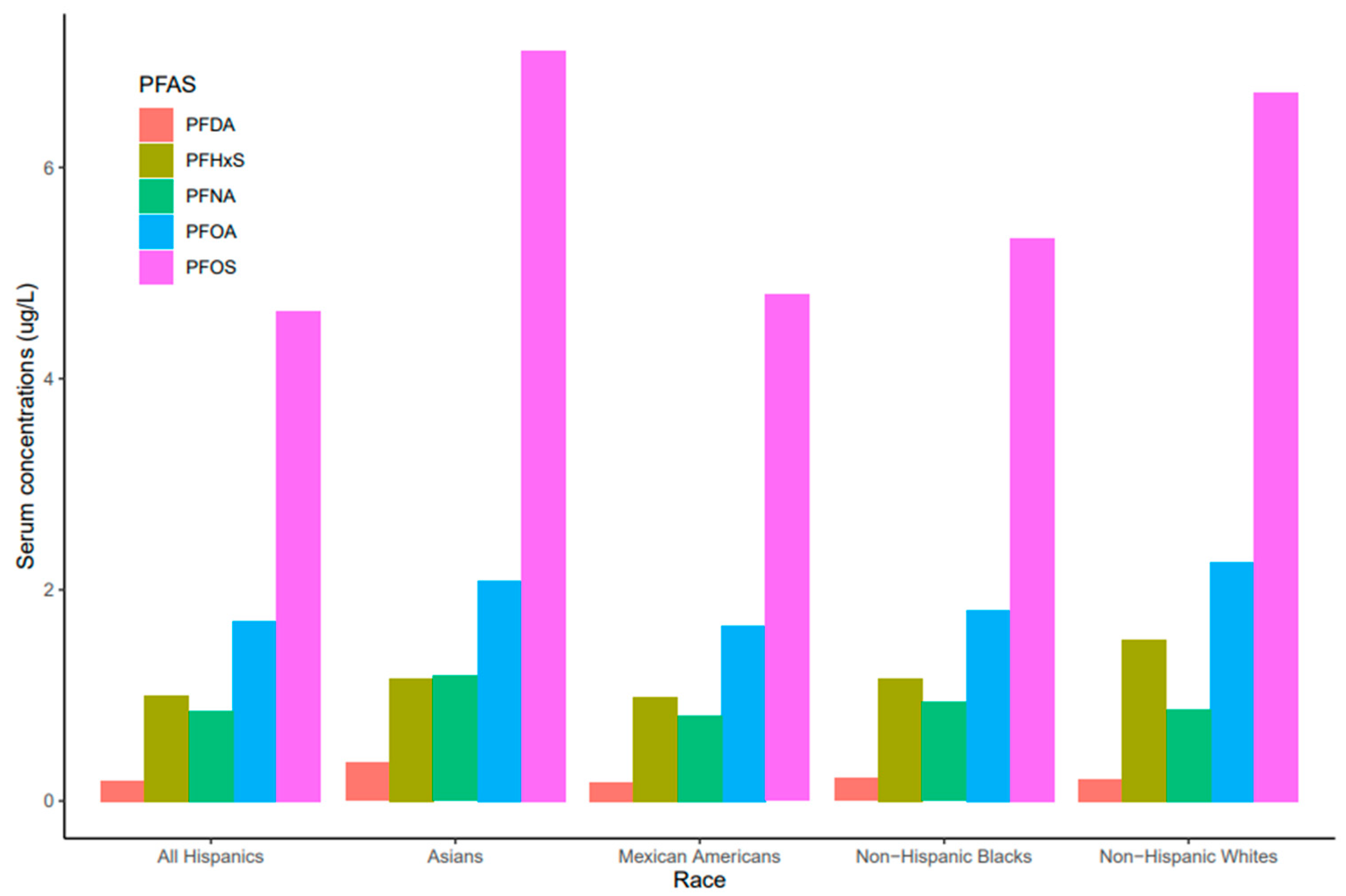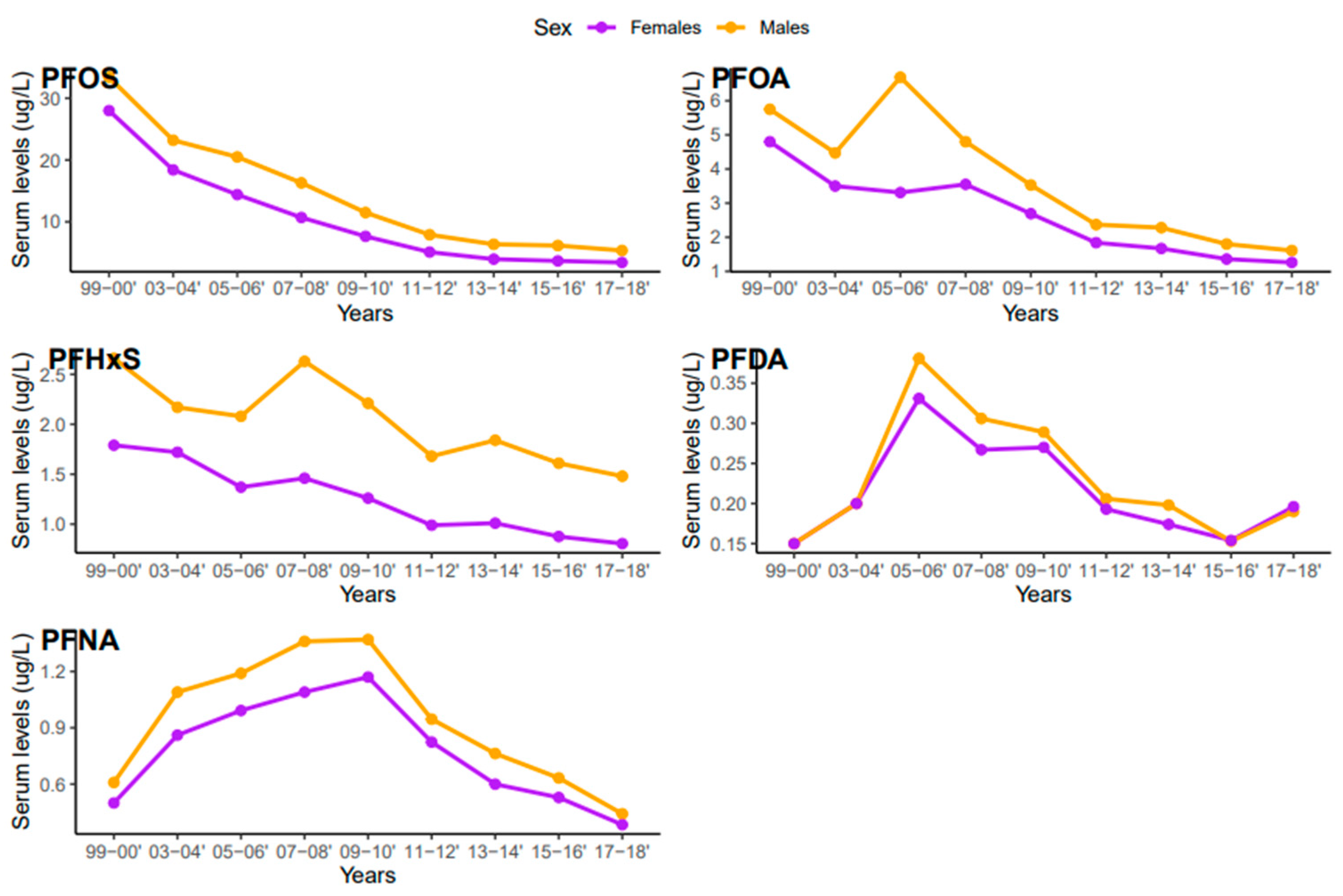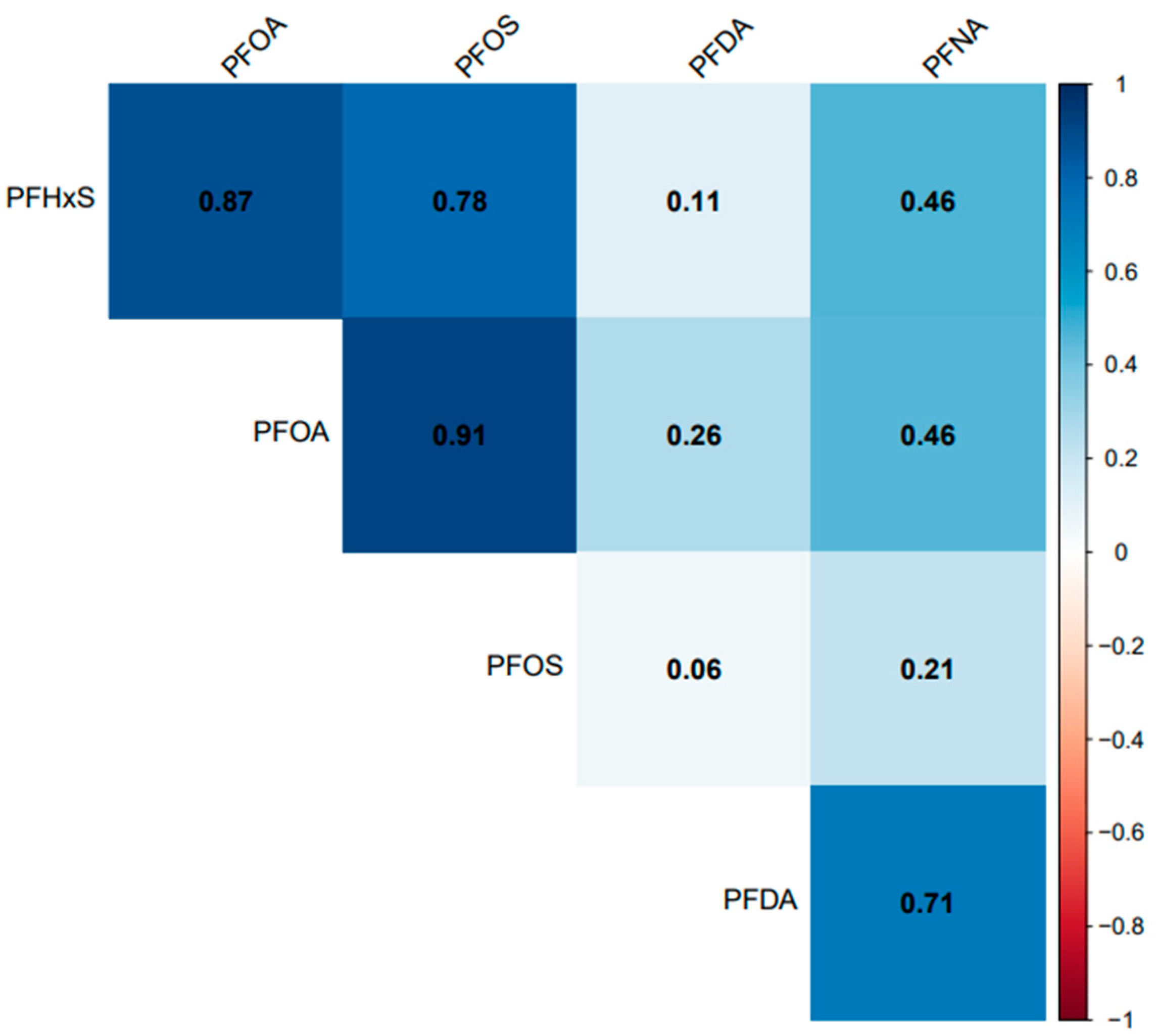Trends in Serum Per- and Polyfluoroalkyl Substance (PFAS) Concentrations in Teenagers and Adults, 1999–2018 NHANES
Abstract
:1. Introduction
2. Materials and Methods
2.1. Cohort Study
2.2. Data Analysis
3. Results
4. Discussion
4.1. Variations in Serum Levels of PFAS
4.2. Serum PFAS among Race/Ethnicity
4.3. Serum Concentrations of PFAS among Male and Female
4.4. Serum Concentrations of PFAS among Age Groups
5. Conclusions
Limitation to the Study
Author Contributions
Funding
Institutional Review Board Statement
Informed Consent Statement
Data Availability Statement
Acknowledgments
Conflicts of Interest
References
- Zhao, Y.G.; Wong, C.K.C.; Wong, M.H. Environmental contamination, human exposure and body loadings of perfluorooctane sulfonate (PFOS), focusing on Asian countries. Chemosphere 2012, 89, 355–368. [Google Scholar] [CrossRef]
- Holmström, K.E.; Järnberg, U.; Bignert, A. Temporal trends of PFOS and PFOA in guillemot eggs from the Baltic Sea, 1968–2003. Environ. Sci. Technol. 2005, 39, 80–84. [Google Scholar] [CrossRef]
- Cai, M.; Zhao, Z.; Yin, Z.; Ahrens, L.; Huang, P.; Cai, M.; Yang, H.; He, J.; Sturm, R.; Ebinghaus, R.; et al. Occurrence of perfluoroalkyl compounds in surface waters from the North Pacific to the Arctic Ocean. Environ. Sci. Technol. 2012, 46, 661–668. [Google Scholar] [CrossRef]
- Bossi, R.; Riget, F.F.; Dietz, R.; Sonne, C.; Fauser, P.; Dam, M.; Vorkamp, K. Preliminary screening of perfluorooctane sulfonate (PFOS) and other fluorochemicals in fish, birds and marine mammals from Greenland and the Faroe Islands. Environ. Pollut. 2005, 136, 323–329. [Google Scholar] [CrossRef]
- Ghisi, R.; Vamerali, T.; Manzetti, S. Accumulation of perfluorinated alkyl substances (PFAS) in agricultural plants: A review. Environ. Res. 2019, 169, 326–341. [Google Scholar] [CrossRef]
- Olsen, G.W.; Burris, J.M.; Ehresman, D.J.; Froelich, J.W.; Seacat, A.M.; Butenhoff, J.L.; Zobel, L.R. Half-life of serum elimination of perfluorooctanesulfonate, perfluorohexanesulfonate, and perfluorooctanoate in retired fluorochemical production workers. Environ. Health Perspect. 2007, 115, 1298–1305. [Google Scholar] [CrossRef]
- Marlissa Campbell, A.K.; Li, L.-H.; Iyer, P.; Moran, F.; Kaufman, F.; Niknam, Y. Proposition 65 Evidence on the Male Reproductive Toxicity of Perfluorononanoic Acid (PFNA) and Its Salts and Perfluorodecanoic Acid (PFDA) and Its Salts. 2021. Available online: https://oehha.ca.gov/media/downloads/crnr/pfnapfdahid100121.pdf (accessed on 15 July 2023).
- Glüge, J.; Scheringer, M.; Cousins, I.T.; DeWitt, J.C.; Goldenman, G.; Herzke, D.; Lohmann, R.; Ng, C.A.; Trier, X.; Wang, Z. An overview of the uses of per- and polyfluoroalkyl substances (PFAS). Environ. Sci. Process. Impacts 2021, 176, 139–148. [Google Scholar] [CrossRef]
- Knutsen, H.K.; Alexander, J.; Barregård, L.; Bignami, M.; Brüschweiler, B.; Ceccatelli, S.; Cottrill, B.; Dinovi, M.; Edler, L.; Grasl-Kraupp, B.; et al. Risk to human health related to the presence of perfluorooctane sulfonic acid and perfluorooctanoic acid in food. EFSA J. 2018, 16, e05194. [Google Scholar] [CrossRef]
- Miller, A.; Elliott, J.E.; Elliott, K.H.; Lee, S.; Cyr, F. Temporal trends of perfluoroalkyl substances (PFAS) in eggs of coastal and offshore birds: Increasing PFAS levels associated with offshore bird species breeding on the Pacific coast of Canada and wintering near Asia. Environ. Toxicol. Chem. 2015, 34, 1799–1808. [Google Scholar] [CrossRef]
- Brase, R.A.; Mullin, E.J.; Spink, D.C. Legacy and emerging per-and polyfluoroalkyl substances: Analytical techniques, environmental fate, and health effects. Int. J. Mol. Sci. 2021, 22, 995. [Google Scholar] [CrossRef]
- Trudel, D.; Horowitz, L.; Wormuth, M.; Scheringer, M.; Cousins, I.T.; Hungerbühler, K. Estimating consumer exposure to PFOS and PFOA. Risk Anal. 2008, 28, 251–269. [Google Scholar] [CrossRef]
- Kusi, J.; Scheuerman, P.R.; Maier, K.J. Antimicrobial properties of silver nanoparticles may interfere with fecal indicator bacteria detection in pathogen impaired streams. Environ. Pollut. 2020, 263, 114536. [Google Scholar] [CrossRef]
- Sim, K.H.; Lee, Y.J. Perfluorohexane sulfonate induces memory impairment and downregulation of neuroproteins via NMDA receptor-mediated PKC-ERK/AMPK signaling pathway. Chemosphere 2022, 288, 132503. [Google Scholar] [CrossRef]
- Bell, K.S.; O’Shaughnessy, K.L. The development and function of the brain barriers—An overlooked consideration for chemical toxicity. Front. Toxicol. 2022, 4, 1000212. [Google Scholar] [CrossRef]
- Garfield, J.; Harris, S. Chemicals Known to the State to Cause Cancer or Reproductive Toxicity; California Environmental Protection Agency: Sacramento, CA, USA, 2023. Available online: https://oehha.ca.gov/media/downloads/proposition-65//p65chemicalslist.pdf (accessed on 15 July 2023).
- Wen, X.; Xu, X. Exposure to Per- and Polyfluoroalkyl Substances and Mortality in U.S. Adults: A Population-Based Cohort Study. Environ. Health Perspect. 2022, 130, 067007. [Google Scholar] [CrossRef]
- Bashir, T.; Obeng-Gyasi, E. The Association between Multiple Per-and Polyfluoroalkyl Substances’ Serum Levels and Allostatic Load. Int. J. Environ. Res. Public Health 2022, 19, 5455. [Google Scholar] [CrossRef]
- Wattigney, W.A.; Savadatti, S.S.; Liu, M.; Pavuk, M.; Lewis-Michl, E.; Kannan, K.; Wang, W.; Spliethoff, H.; Marquez-Bravo, L.; Hwang, S.A. Biomonitoring of per- and polyfluoroalkyl substances in minority angler communities in central New York State. Environ. Res. 2022, 204, 112309. [Google Scholar] [CrossRef]
- Boronow, K.E.; Brody, J.G.; Schaider, L.A.; Peaslee, G.F.; Havas, L.; Cohn, B.A. Serum concentrations of PFASs and exposure-related behaviors in African American and non-Hispanic white women. J. Expo. Sci. Environ. Epidemiol. 2019, 29, 206–217. [Google Scholar] [CrossRef]
- Blake, B.E.; Fenton, S.E. Early life exposure to per- and polyfluoroalkyl substances (PFAS) and latent health outcomes: A review including the placenta as a target tissue and possible driver of peri- and postnatal effects. Toxicology 2020, 443, 152565. [Google Scholar] [CrossRef]
- Centers for Disease and Control Prevention. Biomonitoring Data Tables for Environmental Chemicals. Available online: https://www.cdc.gov/exposurereport/data_tables.html (accessed on 15 July 2023).
- New Jersey Department of Environmental Protection. Determination of perfluorooctanoic acid (PFOA) in aqueous samples: Final report. Available online: http://hdl.handle.net/10929/25465 (accessed on 23 July 2023).
- USEPA. EPA’s Proposal to Limit PFAS in Drinking Water. 2023. Available online: https://www.epa.gov/system/files/documents/2023-04/Fact%20Sheet_PFAS_NPWDR_Final_4.4.23.pdf (accessed on 15 July 2023).
- Takagi, S.; Adachi, F.; Miyano, K.; Koizumi, Y.; Tanaka, H.; Mimura, M.; Watanabe, I.; Tanabe, S.; Kannan, K. Perfluorooctanesulfonate and perfluorooctanoate in raw and treated tap water from Osaka, Japan. Chemosphere 2008, 72, 1409–1412. [Google Scholar] [CrossRef]
- Forsthuber, M.; Kaiser, A.M.; Granitzer, S.; Hassl, I.; Hengstschläger, M.; Stangl, H.; Gundacker, C. Albumin is the major carrier protein for PFOS, PFOA, PFHxS, PFNA and PFDA in human plasma. Environ. Int. 2020, 137, 105324. [Google Scholar] [CrossRef]
- EPA. Drinking Water Health Advisory for Perfluorooctanoic Acid (PFOA); United States Environmental Protection Agency: Washington, DC, USA, 2016; pp. 1–103. Available online: https://www.epa.gov/sites/production/files/2016-05/documents/pfoa_health_advisory_final_508.pdf (accessed on 15 July 2023).
- Pizzurro, D.M.; Seeley, M.; Kerper, L.E.; Beck, B.D. Interspecies differences in perfluoroalkyl substances (PFAS)toxicokinetics and application to health-based criteria. Regul. Toxicol. Pharmacol. 2019, 106, 239–250. [Google Scholar] [CrossRef] [PubMed]
- Chi, Q.; Li, Z.; Huang, J.; Ma, J.; Wang, X. Interactions of perfluorooctanoic acid and perfluorooctanesulfonic acid with serum albumins by native mass spectrometry, fluorescence and molecular docking. Chemosphere 2018, 198, 442–449. [Google Scholar] [CrossRef]
- Agency for Toxic Substances and Disease Registry. PFAS in the U.S. Population. Available online: https://www.atsdr.cdc.gov/pfas/health-effects/us-population.html (accessed on 23 July 2023).
- Christensen, B.T.; Calkins, M.M. Occupational exposure to per- and polyfluoroalkyl substances: A scope review of the literature from 1980–2021. J. Expo. Sci. Environ. Epidemiol. 2023, 33, 673–686. [Google Scholar] [CrossRef]
- European Chemicals Agency (ECHA). Substance Name: Nonadecafluorodecanoic Acid (PFDA) and Its Sodium and Ammonium Salts. 2016. Available online: https://echa.europa.eu/documents/10162/77191b64-4f79-0e53-0b89-57098caf46c4 (accessed on 15 July 2023).
- Dalahmeh, S.; Tirgani, S.; Komakech, A.J.; Niwagaba, C.B.; Ahrens, L. Per- and polyfluoroalkyl substances (PFASs) in water, soil and plants in wetlands and agricultural areas in Kampala, Uganda. Sci. Total Environ. 2018, 631–632, 660–667. [Google Scholar] [CrossRef] [PubMed]
- Hurley, S.; Goldberg, D.; Wang, M.; Park, J.S.; Petreas, M.; Bernstein, L.; Anton-Culver, H.; Nelson, D.O.; Reynolds, P. Time Trends in Per- and Polyfluoroalkyl Substances (PFASs) in California Women: Declining Serum Levels, 2011–2015. Environ. Sci. Technol. 2018, 52, 277–287. [Google Scholar] [CrossRef]
- U.S. Food and Drug Administration. Authorized Uses of PFAS in Food Contact Applications. 2016. Available online: https://www.fda.gov/food/process-contaminants-food/authorized-uses-pfas-food-contact-applications#:~:text=In2016%2CtheFDArevoked,soldintheUnitedStates (accessed on 20 June 2023).
- Kang, H.; Calafat, A.M.; Karvonen-Gutierrez, C.A.; Park, S.K. Isomer-Specific Serum Concentrations of Perfluorooctane Sulfonic Acid among U.S. Adults: Results from the National Health and Nutrition Examination Survey (NHANES) and the Study of Women’s Health Across the Nation Multi-Pollutant Study (SWAN-MPS). Environ. Sci. Technol. 2023, 57, 385–394. [Google Scholar] [CrossRef]
- Kato, K.; Wong, L.Y.; Jia, L.T.; Kuklenyik, Z.; Calafat, A.M. Trends in exposure to polyfluoroalkyl chemicals in the U.S. population: 1999–2008. Environ. Sci. Technol. 2011, 45, 8037–8045. [Google Scholar] [CrossRef]
- Park, S.K.; Peng, Q.; Ding, N.; Mukherjee, B.; Harlow, S.D. Determinants of per- and polyfluoroalkyl substances (PFAS) in midlife women: Evidence of racial/ethnic and geographic differences in PFAS exposure. Environ. Res. 2019, 175, 186–199. [Google Scholar] [CrossRef] [PubMed]
- Calafat, A.M.; Kato, K.; Hubbard, K.; Jia, T.; Botelho, J.C.; Wong, L.Y. Legacy and alternative per- and polyfluoroalkyl substances in the U.S. general population: Paired serum-urine data from the 2013–2014 National Health and Nutrition Examination Survey. Environ. Int. 2019, 131, 105048. [Google Scholar] [CrossRef] [PubMed]
- Calafat, A.M.; Wong, L.Y.; Kuklenyik, Z.; Reidy, J.A.; Needham, L.L. Polyfluoroalkyl chemicals in the U.S. population: Data from the national health and nutrition examination survey (NHANES) 2003–2004 and comparisons with NHANES 1999–2000. Environ. Health Perspect. 2007, 115, 1596–1602. [Google Scholar] [CrossRef] [PubMed]
- Chang, C.J.; Ryan, P.B.; Smarr, M.M.; Kannan, K.; Panuwet, P.; Dunlop, A.L.; Corwin, E.J.; Barr, D.B. Serum per- and polyfluoroalkyl substance (PFAS) concentrations and predictors of exposure among pregnant African American women in the Atlanta area, Georgia. Environ. Res. 2021, 198, 110445. [Google Scholar] [CrossRef]
- Hu, X.C.; Dassuncao, C.; Zhang, X.; Grandjean, P.; Weihe, P.; Webster, G.M.; Nielsen, F.; Sunderland, E.M. Can profiles of poly- and Perfluoroalkyl substances (PFASs) in human serum provide information on major exposure sources? Environ. Health 2018, 17, 11. [Google Scholar] [CrossRef] [PubMed]
- Ding, N.; Harlow, S.D.; Batterman, S.; Mukherjee, B.; Park, S.K. Longitudinal trends in perfluoroalkyl and polyfluoroalkyl substances among multiethnic midlife women from 1999 to 2011: The Study of Women′s Health Across the Nation. Environ. Int. 2020, 135, 105381. [Google Scholar] [CrossRef]
- Kramer, M.R.; Hogue, C.R. What causes racial disparities in very preterm birth? A biosocial perspective. Epidemiol. Rev. 2009, 31, 84–98. [Google Scholar] [CrossRef]
- Dunlop, A.L.; Salihu, H.M.; Freymann, G.R.; Smith, C.K.; Brann, A.W. Very low birth weight births in Georgia, 1994–2005: Trends and racial disparities. Matern. Child Health J. 2011, 15, 890–898. [Google Scholar] [CrossRef]
- Guo, F.; Zhong, Y.; Wang, Y.; Li, J.; Zhang, J.; Liu, J.; Zhao, Y.; Wu, Y. Perfluorinated compounds in human blood around Bohai Sea, China. Chemosphere 2011, 85, 156–162. [Google Scholar] [CrossRef]
- Fromme, H.; Midasch, O.; Twardella, D.; Angerer, J.; Boehmer, S.; Liebl, B. Occurrence of perfluorinated substances in an adult German population in southern Bavaria. Int. Arch. Occup. Environ. Health 2007, 80, 313–319. [Google Scholar] [CrossRef]
- Kärrman, A.; Mueller, J.F.; Van Bavel, B.; Harden, F.; Toms, L.M.L.; Lindström, G. Levels of 12 perfluorinated chemicals in pooled Australian serum, collected 2002–2003, in relation to age, gender, and region. Environ. Sci. Technol. 2006, 40, 3742–3748. [Google Scholar] [CrossRef]
- Sunderland, E.M.; Hu, X.; Dassuncao, C. A review of pathways of human exposure to PFAS. Physiol. Behav. 2019, 173, 665–676. [Google Scholar]
- Kärrman, A.; Ericson, I.; VanBavel, B.; Ola Darnerud, P.; Aune, M.; Glynn, A.; Ligneli, S.; Lindström, G. Exposure of perfluorinated chemicals through lactation: Levels of matched human milk and serum and a temporal trend, 1996–2004, in Sweden. Environ. Health Perspect. 2007, 115, 226–230. [Google Scholar] [CrossRef] [PubMed]
- Bjerregaard-Olesen, C.; Bach, C.C.; Long, M.; Ghisari, M.; Bossi, R.; Bech, B.H.; Nohr, E.A.; Henriksen, T.B.; Olsen, J.; Bonefeld-Jørgensen, E.C. Time trends of perfluorinated alkyl acids in serum from Danish pregnant women 2008–2013. Environ. Int. 2016, 91, 14–21. [Google Scholar] [CrossRef]
- Zhang, T.; Wu, Q.; Sun, H.W.; Rao, J.; Kannan, K. Perchlorate and iodide in whole blood samples from infants, children, and adults in Nanchang, China. Environ. Sci. Technol. 2010, 44, 6947–6953. [Google Scholar] [CrossRef] [PubMed]
- Haug, L.S.; Thomsen, C.; Becher, G. Time trends and the influence of age and gender on serum concentrations of perfluorinated compounds in archived human samples. Environ. Sci. Technol. 2009, 43, 2131–2136. [Google Scholar] [CrossRef]








Disclaimer/Publisher’s Note: The statements, opinions and data contained in all publications are solely those of the individual author(s) and contributor(s) and not of MDPI and/or the editor(s). MDPI and/or the editor(s) disclaim responsibility for any injury to people or property resulting from any ideas, methods, instructions or products referred to in the content. |
© 2023 by the authors. Licensee MDPI, Basel, Switzerland. This article is an open access article distributed under the terms and conditions of the Creative Commons Attribution (CC BY) license (https://creativecommons.org/licenses/by/4.0/).
Share and Cite
Sonnenberg, N.K.; Ojewole, A.E.; Ojewole, C.O.; Lucky, O.P.; Kusi, J. Trends in Serum Per- and Polyfluoroalkyl Substance (PFAS) Concentrations in Teenagers and Adults, 1999–2018 NHANES. Int. J. Environ. Res. Public Health 2023, 20, 6984. https://doi.org/10.3390/ijerph20216984
Sonnenberg NK, Ojewole AE, Ojewole CO, Lucky OP, Kusi J. Trends in Serum Per- and Polyfluoroalkyl Substance (PFAS) Concentrations in Teenagers and Adults, 1999–2018 NHANES. International Journal of Environmental Research and Public Health. 2023; 20(21):6984. https://doi.org/10.3390/ijerph20216984
Chicago/Turabian StyleSonnenberg, Nilisha Khadgi, Akinloye Emmanuel Ojewole, Catherine Oluwalopeye Ojewole, Otite Precious Lucky, and Joseph Kusi. 2023. "Trends in Serum Per- and Polyfluoroalkyl Substance (PFAS) Concentrations in Teenagers and Adults, 1999–2018 NHANES" International Journal of Environmental Research and Public Health 20, no. 21: 6984. https://doi.org/10.3390/ijerph20216984
APA StyleSonnenberg, N. K., Ojewole, A. E., Ojewole, C. O., Lucky, O. P., & Kusi, J. (2023). Trends in Serum Per- and Polyfluoroalkyl Substance (PFAS) Concentrations in Teenagers and Adults, 1999–2018 NHANES. International Journal of Environmental Research and Public Health, 20(21), 6984. https://doi.org/10.3390/ijerph20216984





